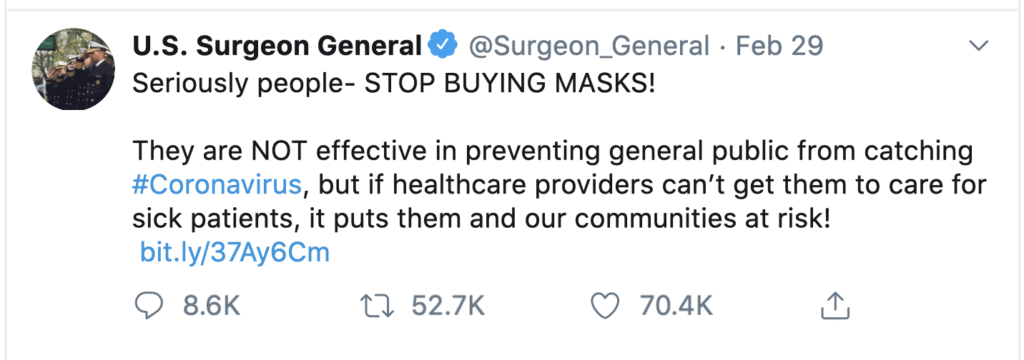
Mixed messages are needlessly killing people
Sending mixed messages never helps
Mixed messages never help you or your audience. They can even kill people, as we’ll surely learn from future case histories on coronavirus communications.
Unfortunately, leaders are learning the hard way that effective messages need to be true, clear, concise, coherent and consistent. Consistency equals credibility, neuroscience shows.

One question that undermines the quest to beat the plague is this: Do you need to wear a mask to prevent the spread of coronavirus?
It’s hard for Americans to know because we’ve heard mixed messages from healthcare and government leaders. You may hold a strong opinion on the topic.
Mixed messages have broken trust, divided the United States, led to needless sickness and deaths, and left people wondering, who can be trusted?
In the meantime, people are dying because public health and elected officials can’t keep their story straight.
We need a leader who will deliver one clear, concise, consistent message
We also need a set of clear guidelines that people can understand and follow. Tragically, both are lacking.
Months into the crisis, health and government authorities’ messages remain inconsistent. They’ve delivered so many mixed messages, people can’t tell what the truth is.
“When there’s an absence of consistent messaging from authorities, many rumors and conspiracy theories can fill the void, and that makes it very difficult for people to figure out what it is that they should do,” Roxane Cohen Silver, a University of California Irvine professor of psychological science, told National Geographic.
Some turn to doctors like Dr. Anthony Fauci, others to friends and family, others to political leaders.
To get good information, ask your doctor
As Dr. Yoo Jung Kim wrote in Fast Company, “The truth is often hopelessly complicated, but the best lies are simple and easy to believe.”
Masks became a flashpoint on February 29, when the U.S. Surgeon General Jerome Adams tweeted that people didn’t need to wear masks.

When it became evident that people without symptoms can spread coronavirus, Adams reversed his position and said people need to wear a mask. But by then, it was too late. The damage had already been done.
After the fears of a mask shortage eased, authorities told people they need to wear masks – contradicting what they’d said before. Credibility went down the drain.
Now, even after more than 125,000 coronavirus deaths in America, mixed messages continue to kill people:
- Switching from “You don’t need a mask” to “You do need a mask” was mind-blowing – especially when so many people harbor doubts about science.
- Some leaders who say you should wear a mask don’t wear one themselves. Should people do as they say, or do as they do?
- Leaders are not singing from the same songbook: some are pro-mask, others anti-mask. As a result, Americans are polarized, with many viewing masks through a political rather than a medical lens.
“There has to be a clear coherent sustained communication, and that has absolutely not happened,” Dr. William Schaffner, an infectious diseases specialist at Vanderbilt University in Nashville, told the New York Times. “We’ve had just the opposite and now it’s hard to unring a whole series of bells.”
What does it take to unring a bell?
A leader with the guts to admit: “Sorry, I was wrong. We’ve learned more about coronavirus, and now I realize what I said before was wrong. I regret it. Now, here’s what you need to know …”
Here’s the thing: Coronavirus doesn’t care what you believe. It can sicken or kill anyone.
Above all, I want you and yours to live through this crisis. Until we have a vaccine that works, wearing a mask in public is one way to keep the people you love safe.
It’s crucial for leaders to get their story straight and avoid mixed messages.
Even leaders who were wrong in the past.
Work together to co-create one message, the sooner, the better. Get on the same page.
Deliver a clear, concise and consistent message. That’s how you can help resolve the plague we’re suffering through.
Among the victims of coronavirus is my mother-in-law Carla Osgood, whom we lost last week. Her death was heartbreaking.
I have to wonder: Would she still be alive today, if leaders had delivered a truthful, consistent message about masks months ago? That gnaws at me. Maybe it always will.
Mixed messages about coronavirus frustrate me because they’re a solvable problem, one that our clients face up to and solve every day.
It’s time for leaders to step up and deliver one clear, concise, consistent message. Many lives depend on it.
Related Posts
Debriefing: The critical crisis communications step you need to take now
When the coronavirus crisis hit, companies who were affected either dusted off their crisis communications plans or made things up as they went along....
Your calm, care and generosity will see you through
Today’s blog is about you I’m writing this blog because I want you to make it through the coronavirus crisis. Elbow bump. Virtual hug....
Three tips to help your employees spot a crisis
The good news: most established companies have some sort of business continuity and crisis communications plan. Hopefully your company has one. The bad news:...
What to say when you don’t know what to say – leadership in a crisis
Leadership in a crisis When friends from other countries ask, “What is happening to the USA?”, I don’t know what to tell them. What’s...





